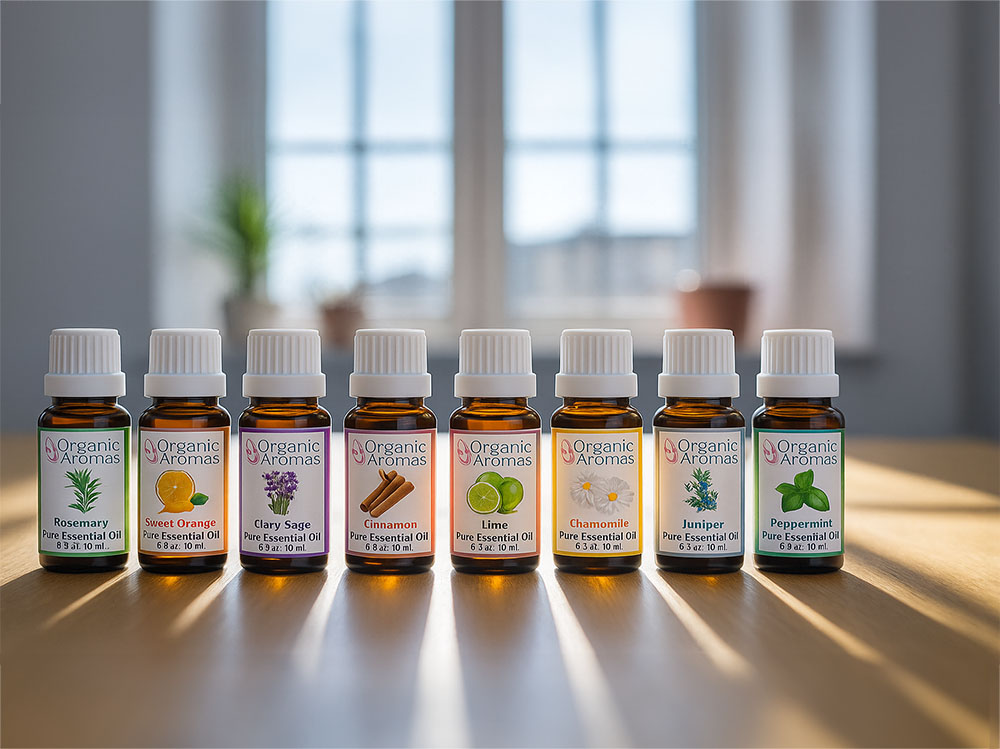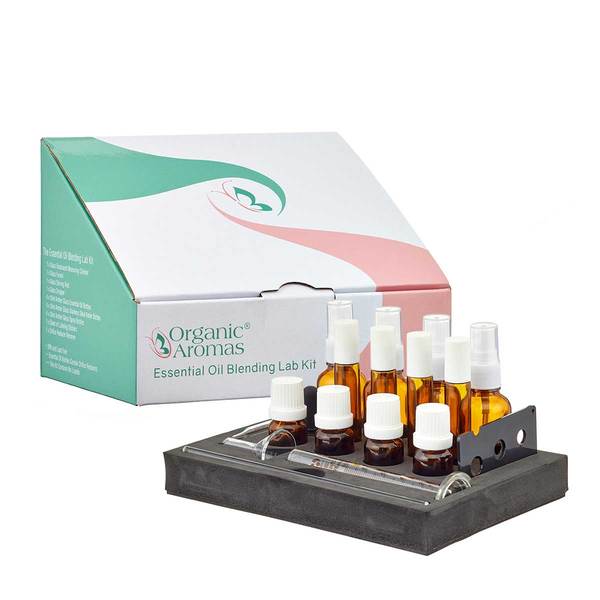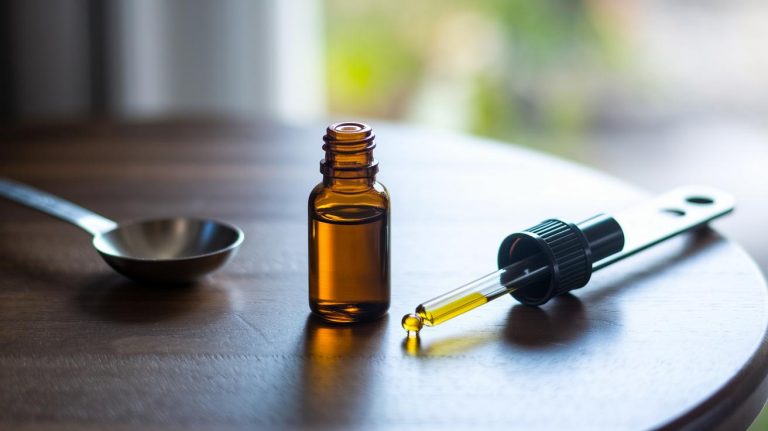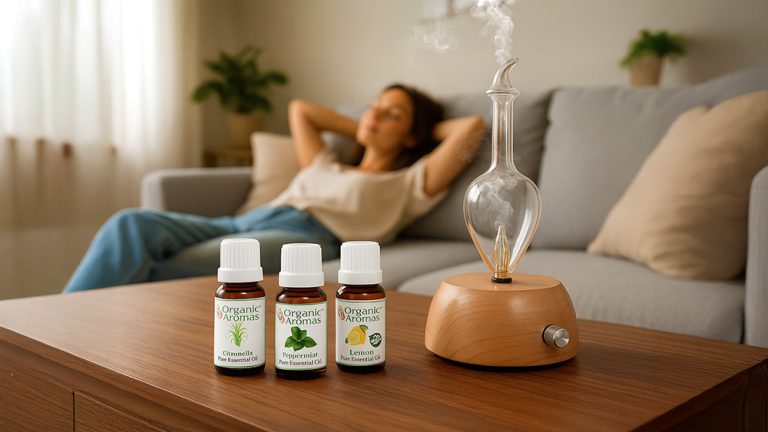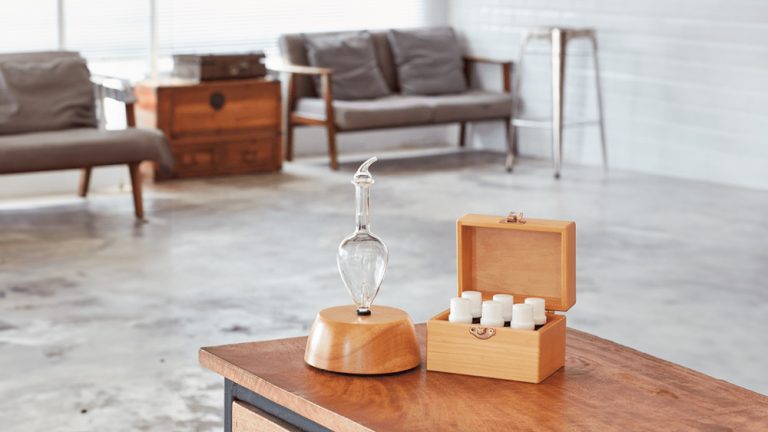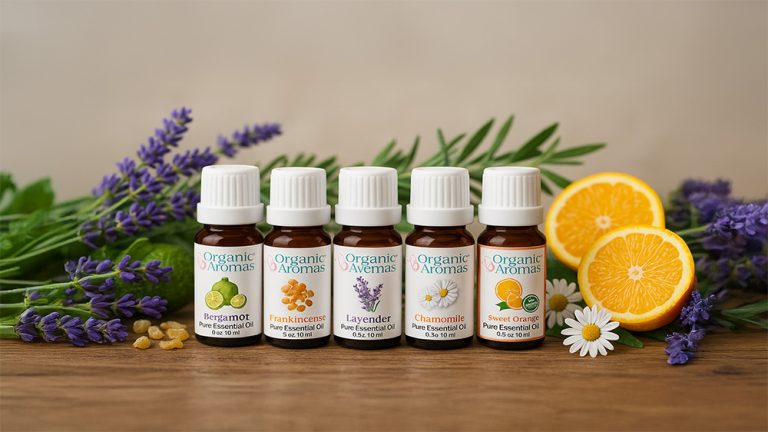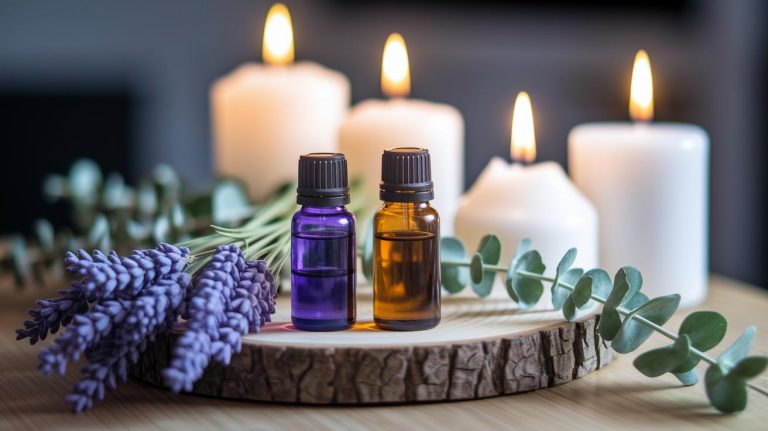5 Essential Oil Blending Chart Sparks Perfect Scent
Have you ever set up your Organic Aromas Mobile-Mini 2.0 diffuser and felt the Perfect Scent more confusing than calming? You’re not alone.
Imagine a wave of zesty Citrus brightness flowing in. Then, a soft floral hug lifts your mood. The mist drifts in, bringing upbeat energy right into your space.
Here’s a simple chart mapping five aroma families (groups of oils with similar scents): Citrus, Floral, Herbal, Spicy, and Woody – into top, middle, and base roles. Each drop plays its part: bright top notes, soothing middle tones, and lasting base warmth.
Try the 30/50/20 rule for drop ratios. This is the count of drops you mix for top, middle, and base notes. It takes all the guesswork out and helps you craft the perfect scent every time.
Essential Oil Blending Chart Quick-Reference Guide
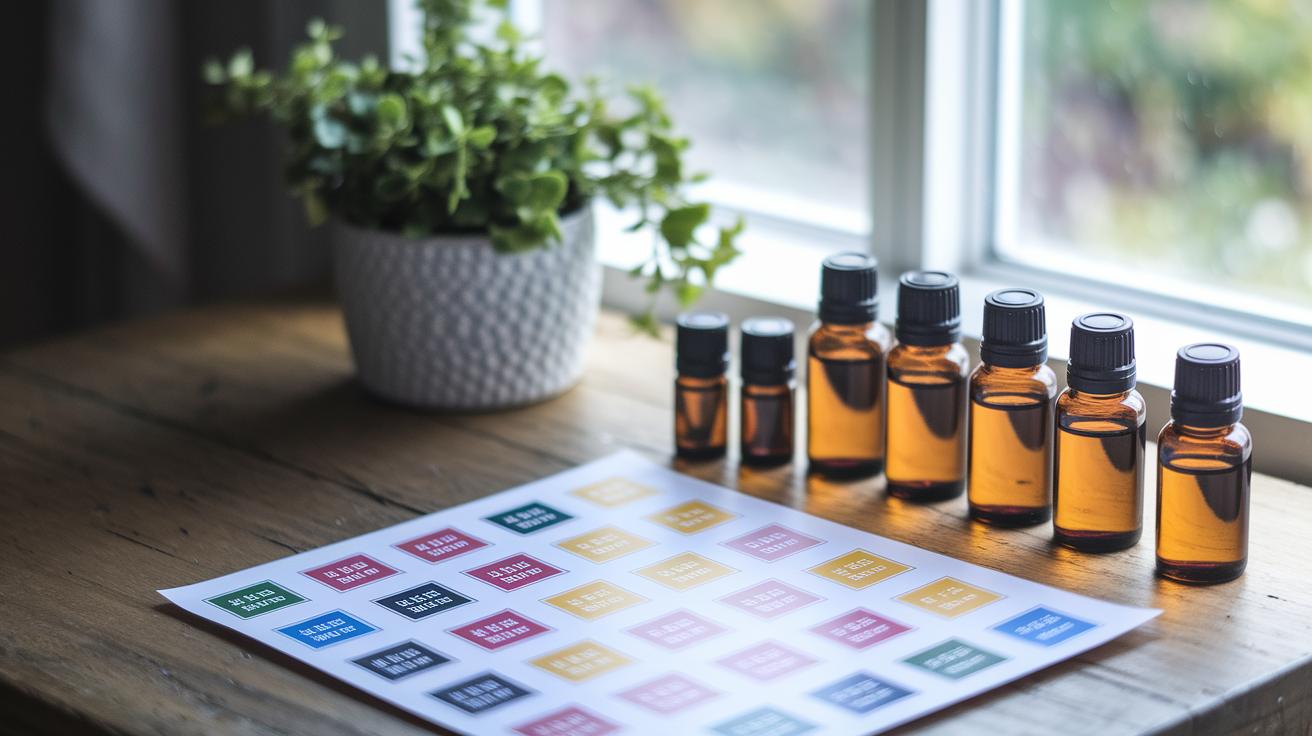
Oils fall into five Perfect Scent fragrance families: Citrus, Floral, Herbal, Spicy, and Woody. They help you craft blends that smell amazing and look beautiful. Each mist carries a fragrant wave and gentle benefits. A zesty blend can brighten your day, while a soft bouquet can soothe your mind.
This chart follows the 30/50/20 rule for note roles. Top notes (lighter scents) lift your mood right away. Middle notes (fuller scents) add body and sweetness. Base notes (rich scents) ground your blend and help it last longer.
Families mix in friendly ways. Citrus oils pair beautifully with Floral, Woody, Herbal, and Spicy oils for bright, zesty blends. Floral oils team up with Herbal and Woody for gentle bouquets. Herbal oils add a fresh twist to Citrus or Floral mixes. Spicy Perfect Scent oils bring warmth to Citrus or Floral blends. Woody oils anchor Floral or Herbal combos with deep, calming depth.
| Oil Family | Example Oils | Note Category | Compatible With | Recommended Ratio (drops) | Therapeutic Benefit |
|---|---|---|---|---|---|
| Citrus | Bergamot | Top | Floral, Woody, Herbal, Spicy | 3 | Mood lift |
| Citrus | Lemon | Top | Floral, Woody, Herbal, Spicy | 3 | Energy boost |
| Citrus | Sweet Orange | Top | Floral, Woody, Herbal, Spicy | 3 | Stress relief |
| Floral | Lavender | Middle | Citrus, Herbal, Woody | 5 | Calm |
| Floral | Geranium | Middle | Citrus, Herbal, Woody | 5 | Hormone balance |
| Floral | Chamomile | Middle | Citrus, Herbal, Woody | 5 | Sleep aid |
| Herbal | Eucalyptus | Top | Citrus, Floral | 3 | Clear airways |
| Herbal | Rosemary | Middle | Citrus, Floral | 5 | Focus |
| Herbal | Peppermint | Middle | Citrus, Floral | 5 | Alertness |
| Spicy | Cinnamon Leaf | Middle | Citrus, Floral | 5 | Warmth |
| Spicy | Ginger | Middle | Citrus, Floral | 5 | Digestive support |
| Spicy | Clove Bud | Middle | Citrus, Floral | 5 | Immune support |
| Woody | Sandalwood | Base | Floral, Herbal | 2 | Grounding |
| Woody | Cedarwood Atlas | Base | Floral, Herbal | 2 | Relaxation |
| Woody | Frankincense | Base | Floral, Herbal | 2 | Spiritual grounding |
Keep blends safe for skin by sticking to a 3% max dilution (mix oils with a carrier oil so they stay gentle).
• Check our full essential oil dilution chart for detailed topical guidelines.
• For quick access, print this chart or tuck a copy into your aromatherapy journal.
Essential Oil Blending Lab Kit
Essential Oil Perfect Scent Blending Note Categories and Roles
In truth, three note categories—top, heart, and base—work together to make a well-rounded blend. Top notes (light scents that arrive first) give you a bright, uplifting welcome. Heart notes (the core aromas) smooth transitions and add comforting depth. Base notes (deep, lingering scents) anchor the mix and keep it grounded.
| Note Category | Role | Examples | Ratio |
|---|---|---|---|
| Top | Light, quick-release scents that greet you first | Bergamot, Lemon | 30% |
| Heart | Core aromas that smooth transitions and add depth | Lavender, Geranium | 50% |
| Base | Rich, lingering notes that anchor the blend | Frankincense, Sandalwood | 20% |
Breathe. Blend. Enjoy.
Recipe Call-Out: Get Grounded
- 3 drops Bergamot
- 5 drops Lavender
- 2 drops Frankincense
Customization Tips
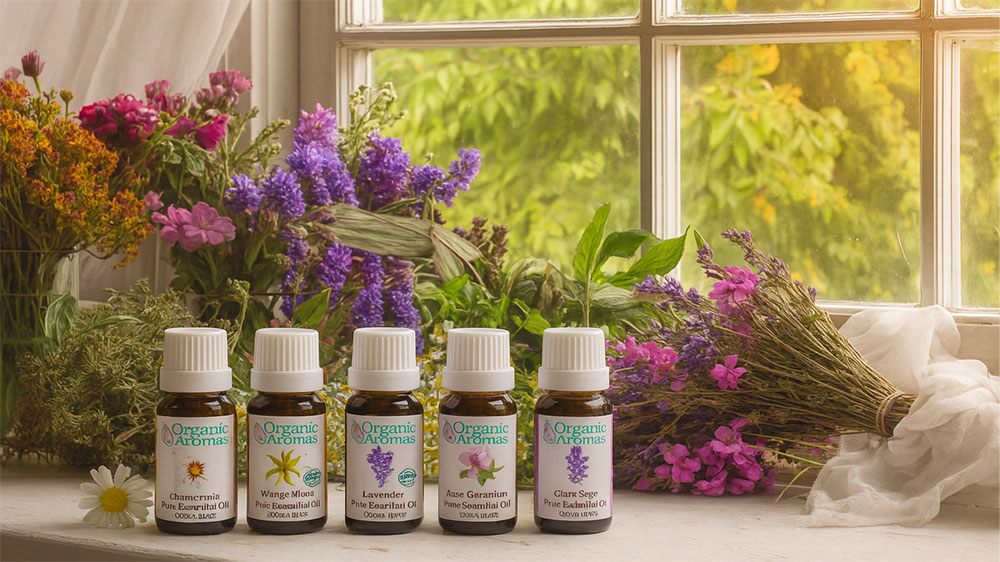
Getting your Perfect Scent blend just right means balancing safety and fragrance. Here are some friendly tweaks to help you dial in that perfect aroma.
- Add a carrier oil column with safe dilution (how strong your mix is). For a child-friendly roll-on, I blend 2% Lavender oil in Jojoba oil (a gentle carrier oil that glides on softly).
- Lay out your blend sheet in a spreadsheet or simple design app. I color-code my heart note (the middle scent layer) pink so I can see the balance at a glance.
- Test and tweak your blends:
- Let your blend rest for 48 hours – this maturation (time for scents to mix) helps the aroma settle.
- Note how the scent evolves. After two days, my bright citrus top notes have mellowed into a round, soft warmth.
Safe Dilution and Carrier Oil Ratios in Blending Charts

At Organic Aromas, we’re all about helping your skin feel calm and smooth. Have you noticed how a perfectly blended massage oil can sink right in? To keep things gentle, follow these safe dilution (how much essential oil you add) and carrier oil (a neutral oil that carries essential oils into your skin) ratios.
| Application | Drops per 1 oz (30 ml) | Dilution | Carrier Oil |
|---|---|---|---|
| Children | 1–3 | ≈ 0.5% | Sweet Almond or Jojoba |
| Adults (long-term) | 10–20 | up to 3% | Sweet Almond or Jojoba |
| Short-term boost (≤ 2 weeks) | 30–60 | up to 10% | Sweet Almond or Jojoba |
Then, let your blend rest in a cool, dark spot for at least 48 hours. That gives all the notes time to mingle and makes your skin feel smoother.
Phototoxic limits for fully diluted blends: lemon oil max 2%, grapefruit oil up to 4%, clove bud oil 0.5%. See the full dilution chart for more details.
5 essential oil blending chart Sparks Perfect Scent
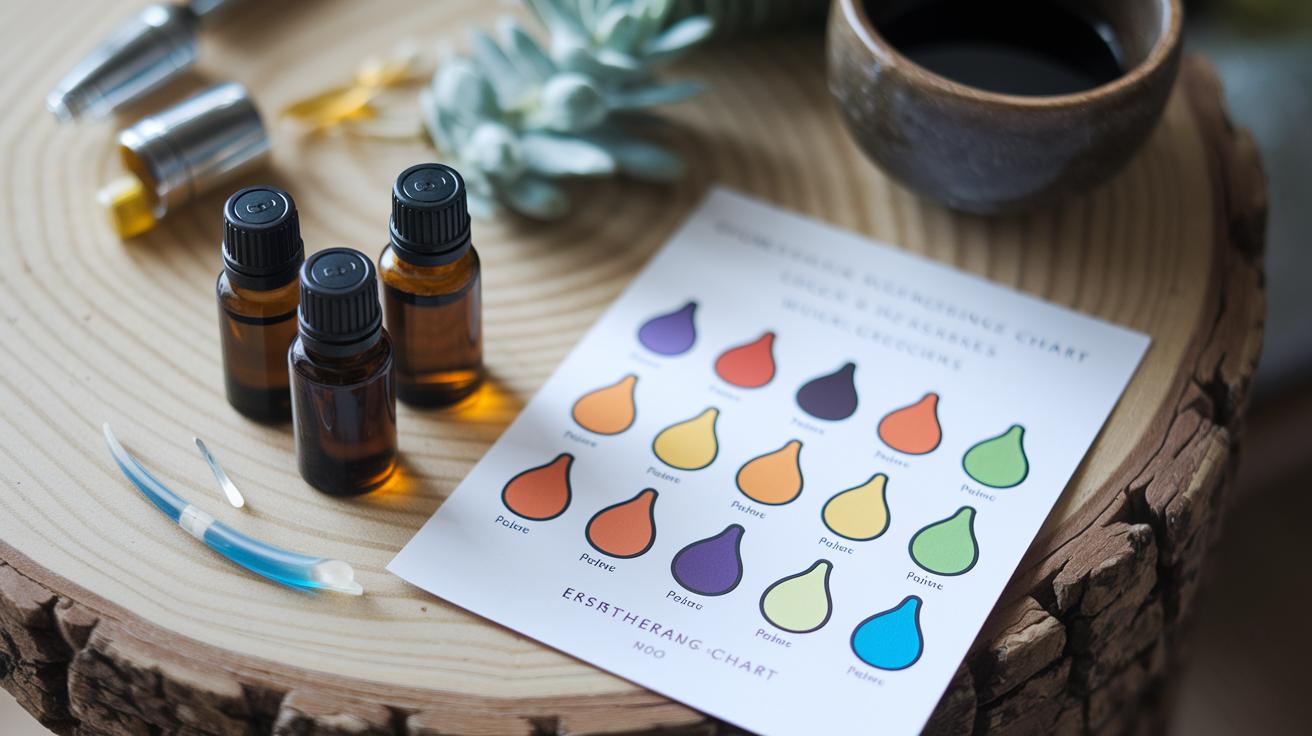
| Goal | Oils & Drops | Benefit |
|---|---|---|
| Calming | Lavender (3), Chamomile (2), Sandalwood (1) | Soothes the mind and eases stress |
| Energizing | Lemon (2), Peppermint (2), Rosemary (1) | Boosts focus and mental clarity |
| Grounding | Frankincense (3), Patchouli (2) | Creates a calm centered mood |
| Immune Support | Eucalyptus (3), Tea Tree (2), Lemon (1) | Clears airways and supports your defenses |
| Sleep Aid | Lavender (3), Chamomile (2), Frankincense (1) | Encourages a restful slumber |
This mini essential oil recipe chart from Organic Aromas is your go-to guide when you need a mood lift or a gentle unwind. Ready for a quick reset? Think of it as a portable mood blend chart you can tweak, like swapping Sandalwood for Cedarwood Atlas in that calming mix to add a warmer, woodsy note.
For stress relief add the Perfect Scent oils to an Organic Aromas nebulizing diffuser (how a fine mist delivers undiluted essential oils). Let the lavender and chamomile mist ripple through your room. Breathe in that soft aroma. Let tension melt away.
At bedtime lean on the sleep blend. First add three drops of Lavender, then two of Chamomile and one of Frankincense into your diffuser. Next, settle in and listen to the soft murmur of chamomile drifting across your space. You’ll soon feel cozy and ready for deep rest.
Keep this blending chart handy by pinning it on a corkboard or snapping a photo for your phone. That way you’ll always have these simple ratios at your fingertips when you want to spark the perfect scent.
Tips for Using and Updating Your Perfect Scent Essential Oil Blending Chart
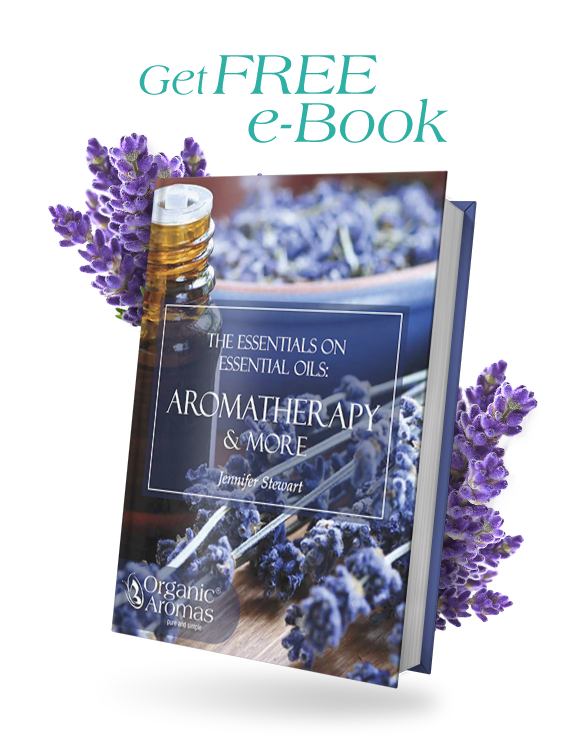
Sign Up to Get Your FREE
e-Book Here…
With your Organic Aromas blending chart, organizing your blends makes every aromatherapy session smoother. Label each amber glass bottle with the blend’s name, date, and exact drop ratio. Grab a fine-tip marker and write something like “Summer Citrus™, 4/15/24, 4 drops bergamot:3 drops grapefruit.”
• Label each amber glass bottle with the blend’s name, date, and exact drop ratio. Grab a fine-tip marker and write something like “Summer Citrus™, 4/15/24, 4 drops bergamot:3 drops grapefruit.” The amber glass blocks light so your mist stays fresh and bright.
• Jot any carrier oil (a neutral oil that dilutes essential oils) swaps right on the bottle, “Switched to fractionated coconut oil.” That way, you’ll notice how the texture and absorption shift with each change.
• Always store your blends in amber glass to protect them from light and preserve their therapeutic aroma. It’s like giving your oils a cozy, protective hug.
• Keep your chart in a cloud folder (for example, “EO Blends 2024”) so you can pull it up on your phone or tablet anytime. Then you can tweak ratios or recall favorites whether you’re at home or out and about.
Final Words
You now have a handy quick-reference table for pairing oils by fragrance family, note role, ratio guidelines and therapeutic uses. The note hierarchy and 30/50/20 rule make blending feel like second nature. Then you learned simple steps to create and customize your own Perfect Scent chart, plus safe dilution limits and carrier oil ratios.
Keep experimenting and let your essential oil blending chart grow with you. Stay inspired and breathe in balance with your Perfect Scent.
Perfect Scent Essential Oil Blending FAQ
1. I’m new to blending. How do I start with my Organic Aromas Mobile-Mini 2.0?
Begin with five fragrance families—Citrus, Floral, Herbal, Spicy, and Woody—and follow the 30/50/20 rule for top, middle, and base notes. This simple ratio removes all guesswork and helps you create balanced, beautiful blends every time.
2. What are the Perfect Scent fragrance families?
Each essential oil belongs to one of five fragrance families:
- Citrus: bright, uplifting
- Floral: soft, comforting
- Herbal: fresh, clarifying
- Spicy: warm, energizing
- Woody: deep, grounding
These families blend naturally with each other.
Citrus pairs well with Floral, Herbal, Woody, and Spicy.
Floral blends smoothly with Herbal and Woody.
Herbal freshens Citrus or Floral.
Spicy warms Citrus or Floral.
Woody anchors Floral or Herbal combinations.
3. What is the 30/50/20 blending rule?
A simple, beginner-friendly blending method:
- 30% Top notes (quick, bright scents like Lemon or Bergamot)
- 50% Middle notes (the body of the aroma, such as Lavender or Geranium)
- 20% Base notes (deep, lingering scents like Frankincense or Sandalwood)
4. Do you have simple starter recipes?
Yes. Here are five easy blends:
Calming
Lavender 3, Chamomile 2, Sandalwood 1
Energizing
Lemon 2, Peppermint 2, Rosemary 1
Grounding
Frankincense 3, Patchouli 2
Immune Support
Eucalyptus 3, Tea Tree 2, Lemon 1
Sleep Aid
Lavender 3, Chamomile 2, Frankincense 1
5. Do I need to dilute essential oils when using a nebulizing diffuser?
No. Organic Aromas nebulizing diffusers use pure essential oils without water or heat.
6. What are the safe dilution ratios for topical use?
Follow these guidelines:
- Children: 1–3 drops per 30 ml (0.5%)
- Adults (long-term): 10–20 drops per 30 ml (up to 3%)
- Short-term use (up to 2 weeks): 30–60 drops per 30 ml (up to 10%)
Suitable carrier oils include Sweet Almond and Jojoba.
7. Are any oils phototoxic?
Yes. Here are the maximum recommended dilutions:
- Lemon: up to 2%
- Grapefruit: up to 4%
- Clove Bud: up to 0.5%
8. How should I store and organize my blends?
Use amber glass bottles to protect the oils from light.
Label each bottle with the blend name, date, and drop ratio.
Note any carrier-oil swaps directly on the label.
Let each blend rest at least 48 hours so the notes can mature and settle.
9. Can I customize the recipes without ruining them?
Yes. Start with small adjustments:
- If the blend is too sharp, reduce Citrus top notes.
- If it lacks body, add 1–2 more middle notes like Lavender.
- If it feels heavy, reduce base notes.
- If it smells unbalanced, let it mature for 48 hours.
10. What’s a good blend for grounding?
Get Grounded
3 drops Bergamot
5 drops Lavender
2 drops Frankincense
11. Why does my blend smell different after a day or two?
Essential oils naturally mature over 48 hours.
Top notes soften, while middle and base notes blend into a smoother, rounder aroma.
12. Should I print or save my blending chart?
Yes. You may print it, keep it in your aromatherapy journal, or save a copy on your phone for quick access anytime you want to craft new blends.

